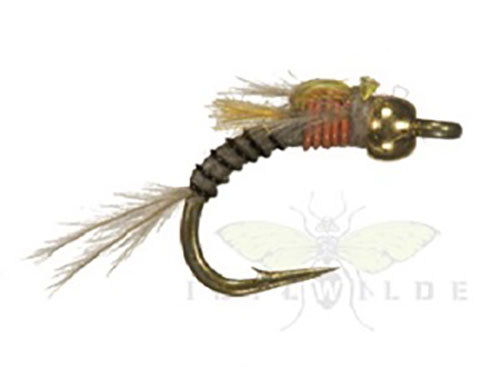Nosepicker Blue Winged Olive
By Kevin Price
Translated by CARL WUEBBEN
When it comes to flies that imitate small Mayfly nymphs, many fly tiers routinely turn to the trusty pheasant tail nymph and its’ derivatives. It’s a fly that is easy to tie and tends to get the job done. It’s such an effective mayfly nymph imitation that creative fly dressers are hard pressed to arrive at anything better. The challenge was to find a fly that lasted more than two or three fish. That’s the one problem with the P.T. nymph: it is made from inherently brittle materials- namely peacock herl and pheasant tail fibers. The answer is a pattern dubbed the Nosepicker, designed to be a true guide’s fly: a fly that not only fools trout, but also stands up to a beating. Moreover, the pattern is easy to tie. Its’ colors and size are easily adapted to match a variety of mayflies. Depending on the bead color, thread, hook size and wire, the Nosepicker can imitate Blue-winged Olives, Pale Morning Duns, Green Drakes, and March Browns. Emu herl is used for the tail and legs because not only does it look buggy and lifelike, and holds its shape in the water, but it’s also amazingly durable. A small strip of pearl flashabou run through a piece of hollow ultra-lace tubing adds just the right amount of flash and creates a nice bulletproof wing case that resembles epoxy, but without the mess of working with epoxy, and it remains intact for the life of the fly. The wire thorax, virtually indestructible, allows for a consistent-sized upper body while also enabling the fly to sink fast. The Nosepicker is as tough as they come. You’ll lose it to a big tippet-busting trout before it’ll fall apart.
PATTERNHOOK - TMC 2488 heavy, sizes #16-#20
HEAD - Gold bead, matched to hook size
THREAD – Olive-Dun UNI thread, size 8/0
TAIL – Olive Emu
RIB – Small olive Ultra wire
SHUCK – Olive CDC
WING CASE – Tan Ultra lace tubing with a strand of pearl Flashabou inside
ABDOMEN – Brassie-size black Uni-wire
LEGS – Olive Emu
NOTE – photo is a pale mourning dun colors but pattern is the sameHOW TO TIE
Debarb hook. Put gold bead onto hook, small hole first and mount in vise. Start thread in right behind beadhead and create a thread base on the hook shank then tie in 3 strands of the Emu fibers for the tail, about ½ to ¾ the hook shank long. Wrap thread back to the beadhead.- Tie in a length of small olive wire behind beadhead and wrap it down with the thread to the base of the tail with close wraps, keeping it in a straight as possible on top of the shank. Then bring your thread back up to the beadhead (close wraps again). Now make four spiral wraps of the wire and tie off. Helicopter the tag end off. Your thread should be about mid-shank now. Tie in a small clump of olive CDC for the shuck in at the mid-shank area facing rearward. (Tie it a bit long so it’s easy to handle, and then trim to length – about the length of your beadhead.)
- Insert a single strand of pearl Flashabou into a length of tan Ultra lace, and tie it in starting up against the beadhead. With the thread, wrap rearward and on top of the larva lace and stop in front of the shuck (olive CDC), leave it facing rearward. We will use it later for the wing case.
- Tie in a strand of black Ultra wire at the base of the shuck and make about six wraps (very close) to form the abdomen. It should end very close to the beadhead. Tie it off and helicopter the tag end off.
- Tie in three strands of olive Emu on each side of the abdomen (black wire) to form the legs. They should extend to about midway of the shuck and tilted slightly upward. One or two thread wraps rearward will keep them facing rearward. Cut off tag ends of Emu.
- Pull the Ultra lace tubing forward, splitting the Emu legs more to the side, and tie off right behind the beadhead. With tight wraps to hold it down well. Clip off the end of tubing and whip finish. Add a small amount of Zap-a-gap to secure the thread.
TIE UP A DOZEN OR TWO – AND GO FISHING*** But remember to practice C.P.R. (CATCH – PICTURE – RELEASE)


